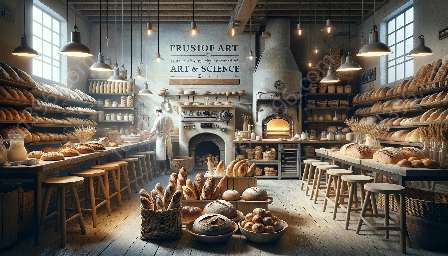Yeast fermentation plays a crucial role in the art and science of baking, particularly in artisan and traditional techniques. This topic cluster delves into the intricate processes of yeast fermentation and its impact on the creation of delicious baked goods. From understanding the fundamentals of fermentation to exploring the role of yeast in crafting various types of bread, this comprehensive guide unravels the mysteries behind this essential aspect of baking.
Understanding Yeast Fermentation
Before delving into the specifics of artisan and traditional baking techniques, it's essential to grasp the basics of yeast fermentation. Yeast, a single-celled fungus, is a key ingredient in the process of fermentation in baking.
Yeast Fermentation Process: Yeast ferments sugars present in dough, producing carbon dioxide and ethanol as byproducts. This process leads to dough rising, imparting the desired light and airy texture to baked goods.
Temperature and Time: Controlling the temperature and fermentation duration are critical factors in achieving optimal results. Artisan bakers often rely on traditional methods, allowing for longer fermentation periods compared to commercial baking practices.
Artisan Baking Techniques
Artisan baking is characterized by its emphasis on traditional methods, handcrafted processes, and the use of high-quality, natural ingredients. Yeast fermentation in artisan baking is a meticulous art that requires skillful mastery of timing and technique.
Fermentation Vessels:
Artisan bakers often utilize traditional fermentation vessels, such as wooden dough troughs or ceramic bowls, to allow for slow, controlled fermentation. This approach contributes to the development of complex flavors and textures in the final baked products.
Sourdough Fermentation:
Sourdough, a natural leavening agent, is a hallmark of artisan baking. Sourdough fermentation involves a symbiotic culture of yeast and lactic acid bacteria, imparting distinct tangy flavors and enhancing the nutritional profile of bread.
Traditional Baking Science & Technology
Incorporating the principles of baking science and technology enhances the precision and consistency of traditional baking methods. Understanding the scientific aspects of yeast fermentation allows bakers to fine-tune their techniques and achieve exceptional results.
Optimizing Fermentation Conditions:
Through precise control of factors such as temperature, humidity, and dough composition, traditional bakers leverage baking science to create ideal conditions for yeast fermentation. This knowledge contributes to the development of unique and flavorful baked goods.
Yeast Varieties and Strains:
Exploring different yeast varieties and strains enables traditional bakers to tailor fermentation processes to specific bread recipes, resulting in varied flavor profiles and textures.
Exploring the Culinary Possibilities
Yeast fermentation in baking opens the door to a myriad of culinary possibilities, from crusty sourdough loaves to delicate pastries. Understanding the interplay between artisan techniques, traditional approaches, and the science of baking empowers bakers to hone their craft and create exceptional baked delights.
Continuing the Tradition
By embracing the artistry of yeast fermentation and upholding the traditions of artisan and traditional baking, bakers contribute to the preservation of time-honored culinary practices and the creation of truly memorable baked goods.



